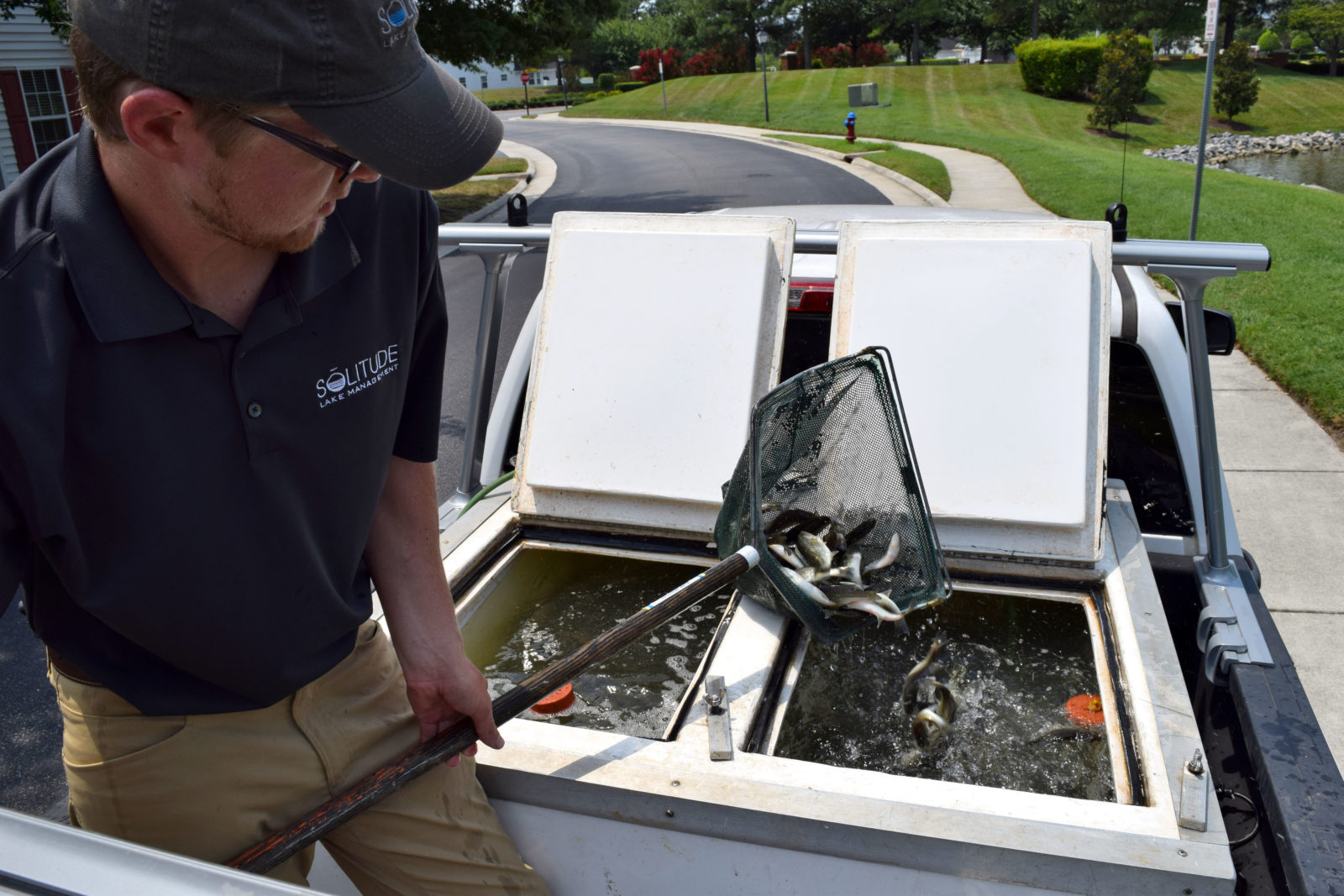
Details & Descriptions of Fish Species For Fish Stocking
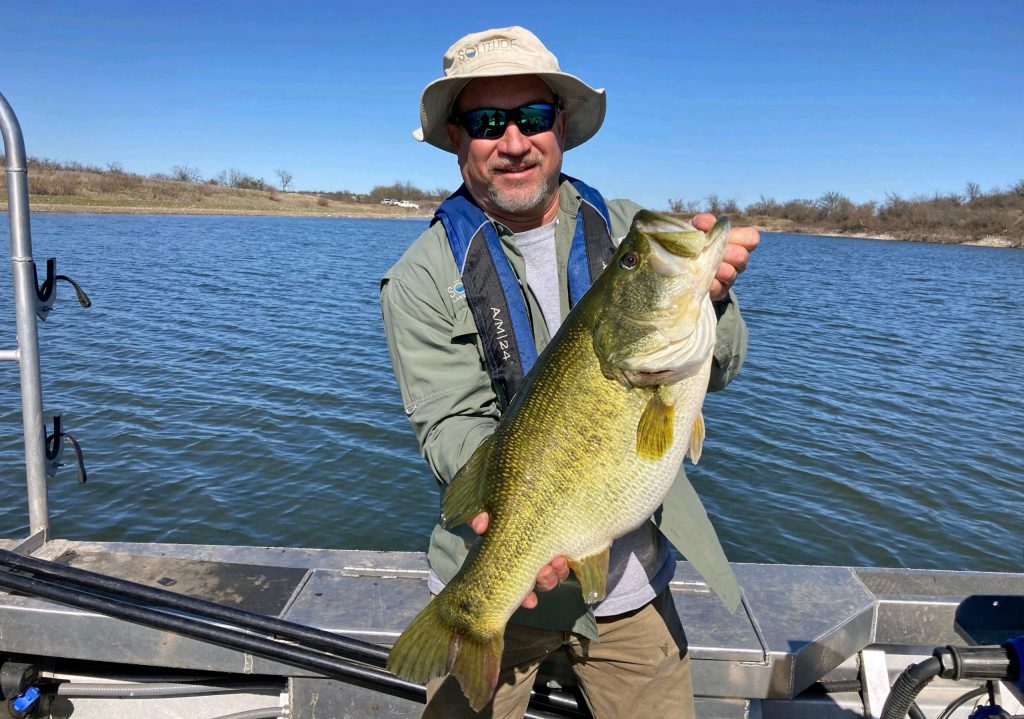
Largemouth Bass (Micropterus salmoides)
Habitat and biology: Spawning occurs from April to late May, when water temperatures reach 63º to 68ºF and takes place in deeper water than sunfishes, usually 1 to 4 feet. Males build the nests which are at least 30 feet apart. After spawning, the female leaves the nest although she, or another female, may return to spawn later. The eggs hatch in 3 to 4 days. Females produce 2000 to 7000 eggs per pound of body weight. Until they are 2 inches long, largemouth juveniles feed on plankton and miscellaneous insects and other invertebrates. Average life span is from 10 to 12 years and they typically grow 12 to 30 inches in length although growth rates are extremely variable depending on the water body. Largemouth have a tendency to become overpopulated and often require active harvest of intermediate size fish to prevent size classes from becoming stunted.
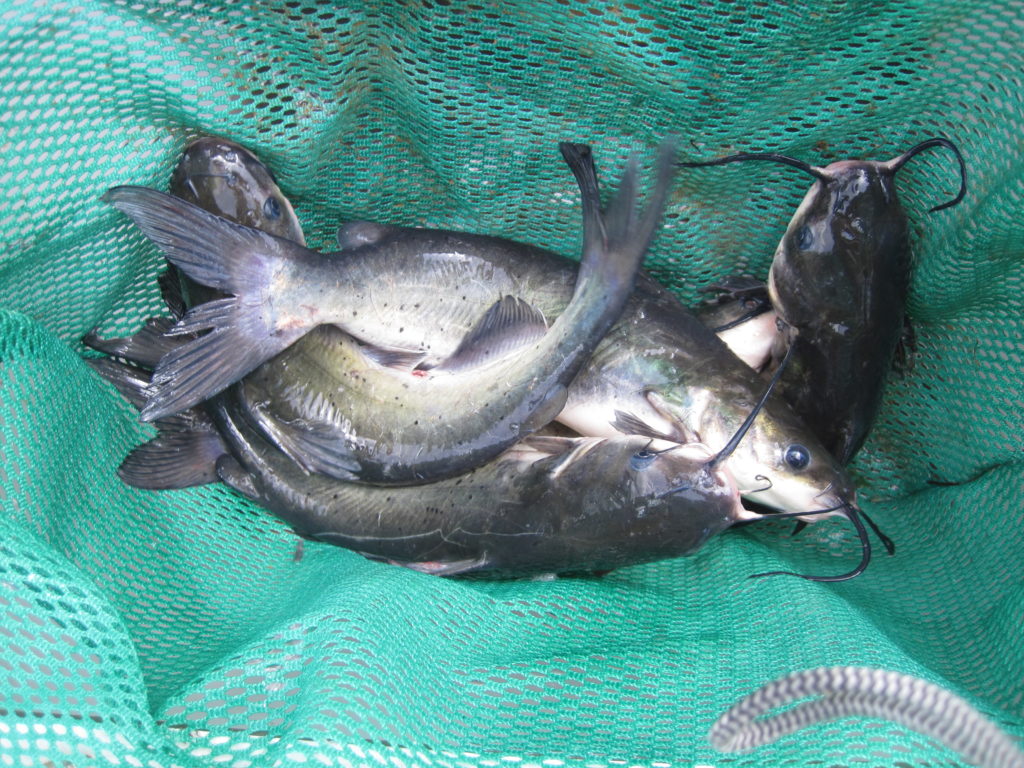
Channel Catfish (Ictalurus punctatus)
Habitat and biology: This slender, elongate catfish has a deeply forked caudal fin. The sides of juveniles and adults have scattered dark spots. Spawning begins in May when water temperatures are between 75 and 85ºF and continue for several months. They do not reproduce well in ponds, but if provided with objects such as barrels or drainage tiles they can successfully spawn. Hatching occurs in 5 to 10 days and males guard the nest and schools of fry and small fish. Maturity is reached at age 5 to 7. The channel catfish is a nocturnal feeder and depends heavily on chemical senses to locate its food. They feed on aquatic insect larvae, crayfish, mollusks, and small fish. Maximum age in northern climates is 24 years and in southern climates 15 years. They grow 15 to 24 inches in length.
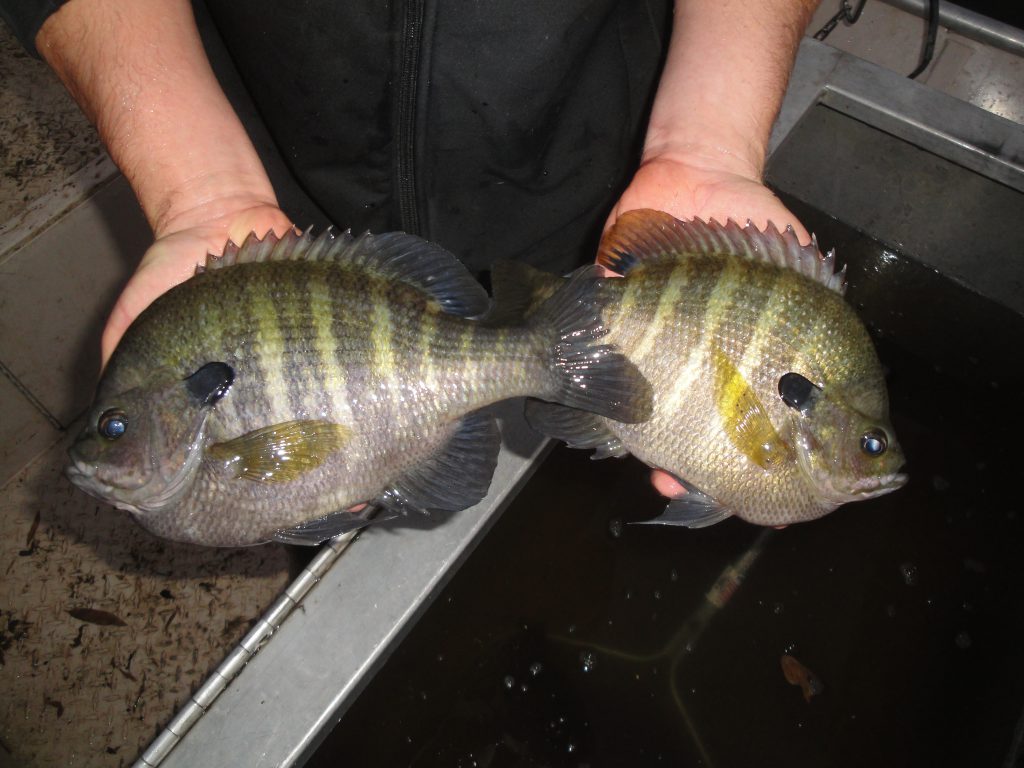
Bluegill (Lepomis macrochirus)
Habitat and biology: Bluegill begin spawning when the water temperature reaches 60°F and they have a protracted spawning season lasting from April to September. The bluegill nests in colonies and prefer sites that are firm sand or mud with some debris but little vegetation. The nests are usually built-in water 1 to 3 feet deep. They typically reach maturity in year 1 or 2. Bluegill are routinely stocked in lakes and ponds as food for Largemouth Bass. The long spawning season of Bluegill give them tremendous reproductive potential. Bluegill feed during the day and most active in the morning and afternoon. They eat a wide variety of organisms including significant amounts of plant material. Young Bluegill feed on plankton while larger individuals eat insects and other larger particles. They feed throughout the water column. Bluegill live for 5 to 6 years and grow 6 to 10 inches in length.
Note: Bluegill are density-dependent, meaning that as their numbers increase, their relative sizes decrease. It is therefore imperative to catch and remove smaller fish to avoid overpopulation if large Bluegill are desired.
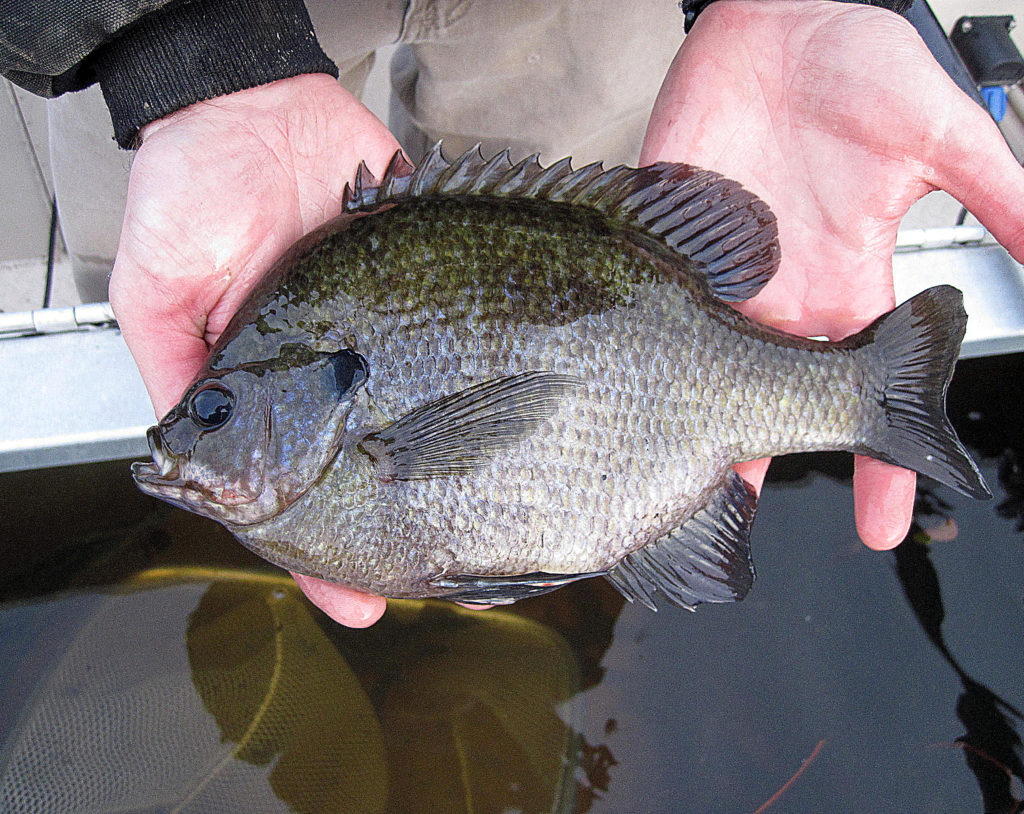
Coppernose Bluegill (Lepomis macrochirus purpurescens)
Characteristics: The Coppernose Bluegill has a deep rounded body in a variety of colors including brown, copper, orange and green with reddish orange to yellow on the belly. Colors are brighter on breeding males. Bluegill can be distinguished from other sunfish by the dark spot on the back of the dorsal fin and also by their very small mouth. Male Coppernose Bluegill have a broad copper band above the eye or forehead that is prominent during spawning season and can also have orange margins to their fins.
Habitat and biology: Young bluegill feed primarily on plankton and then switch to small minnows and insects as they age. Bluegill readily accept pelletized feed, which makes it very straightforward to grow large bluegill for angling and lots of small bluegill to feed your bass. When put on an intensive supplemental feeding program, coppernose bluegill commonly grow faster and larger than native bluegill in small impoundments. This is partly due to their aggressive feeding behavior. Coppernose bluegill will routinely exceed one pound in size when managed with a regular feeding program. Bluegill begin spawning when the water temperature reaches 60°F. These spawns will continue all summer and do not end until water temperature drops below 60 °F in the fall months. The long spawning season of bluegill give them tremendous reproductive potential.
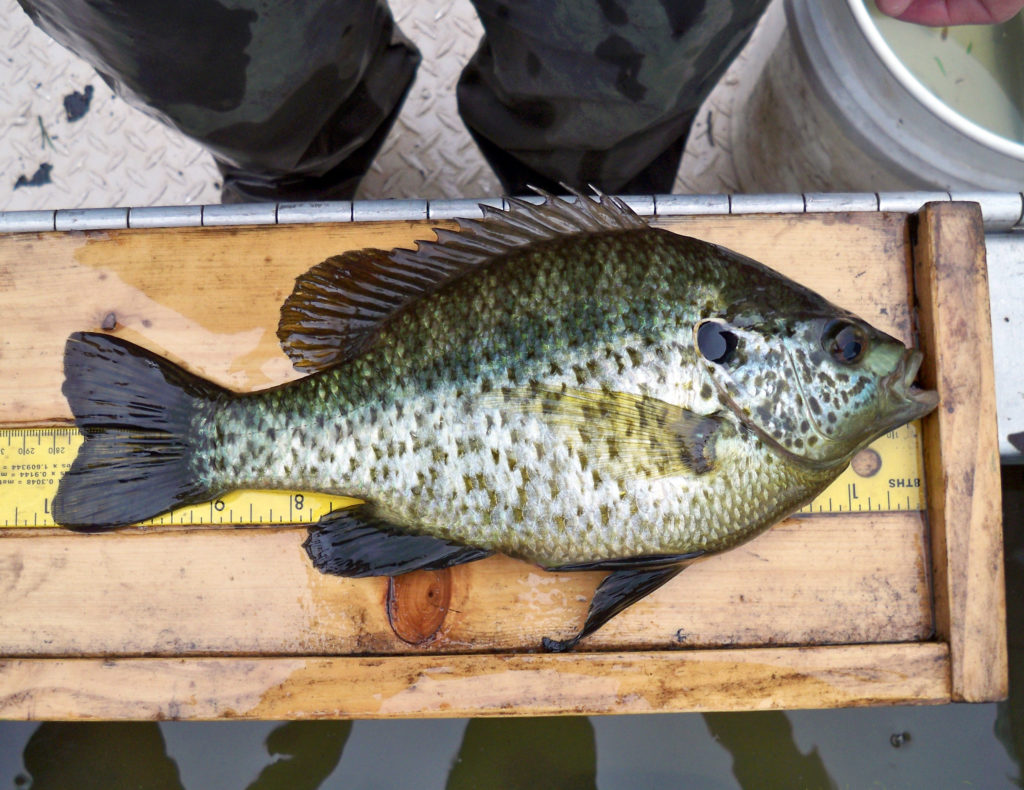
Redear Sunfish (Shellcracker) Lepomis microlophus
Habitat and ecology: Spawning occurs during May, June and July when water temperatures reach 70⁰F. They prefer water three to four feet deep, and a firm, shelly bottom, often near a dropoff. Nesting sites are often near aquatic vegetation. Breeding behavior is similar to other sunfish, with the males doing the nest building and guarding the young. A female may lay between 15,000 to 30,000 eggs during a spawn. Redear sunfish have extensive molar surfaces on the pharyngeal arches and associated musculature that enables the fish to crack mollusk shells, hence the local name of shellcracker. They are usually stocked in small ponds and lakes with bluegill and largemouth bass. They grow quite well in these environments, and because they feed on mollusks and benthic aquatic insect larvae, they do not compete with bluegill. Individuals live for six years and grow 8 to 11 inches in length.
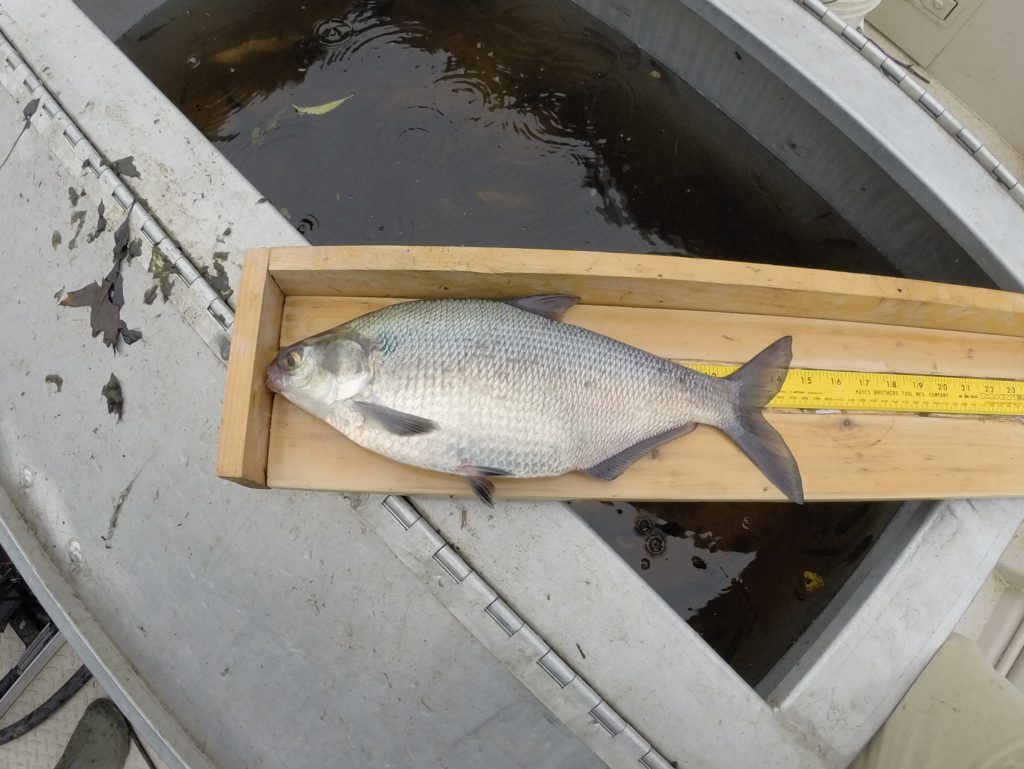
Gizzard Shad (Dorosoma cepedianum)
Characteristics: The gizzard shad is the only member of the family with a blunt snout and an inferior mouth. The last dorsal fin ray on both the gizzard and threadfin shad is elongated and whiplike. The ventral edge of the upper jaw is deeply notched. The back is bluish gray. Some individuals may have a greenish or silver tinge overall, as well as several darker, horizontal bars along the sides. The belly is milky white to silver. The color of the vertical fins is variable, from nearly black during spawning season to clear with irregular black blotches in the fall. They typically grow 8 to 14 inches in length.
Habitat and biology: Although individuals occasionally enter large streams, they occur in greatest abundance in open, quiet waters in rivers and reservoirs. Adults are often found near the surface and the young are common around weed beds. They can also endure moderate salinity and high turbidity. Gizzard shad are a preferred food of the largemouth bass and they reproduce rapidly. Mass spawning occurs at night in open waters when the temperature reaches 50º to 70ºF, usually in April – June. The tiny adhesive eggs float on the water until they hatch or slowly adhere to the bottom. Depending on year class, the female can lay 60,000 to 300,000 eggs. Newly hatched gizzard shad feed on protozoans and other plankton. After a few weeks the diet changes to include phytoplankton and algae. They grow faster than bluegill and are easier for bass to swallow, so large bass benefit from shad introduction. The gizzard shad is essentially a filter feeder, but if plankton is unavailable, will switch its diet to bottom feed on detritus (such as leaf litter) and benthic invertebrates.
Note: The gizzard shad is a valuable forage fish in some waters but it can overpopulate and become a nuisance if there are not enough predators to control its population. Gizzard shad compete directly with larval bluegill for zooplankton as food, therefore pelleted feed is recommended to increase the number of bluegill if shad are present.
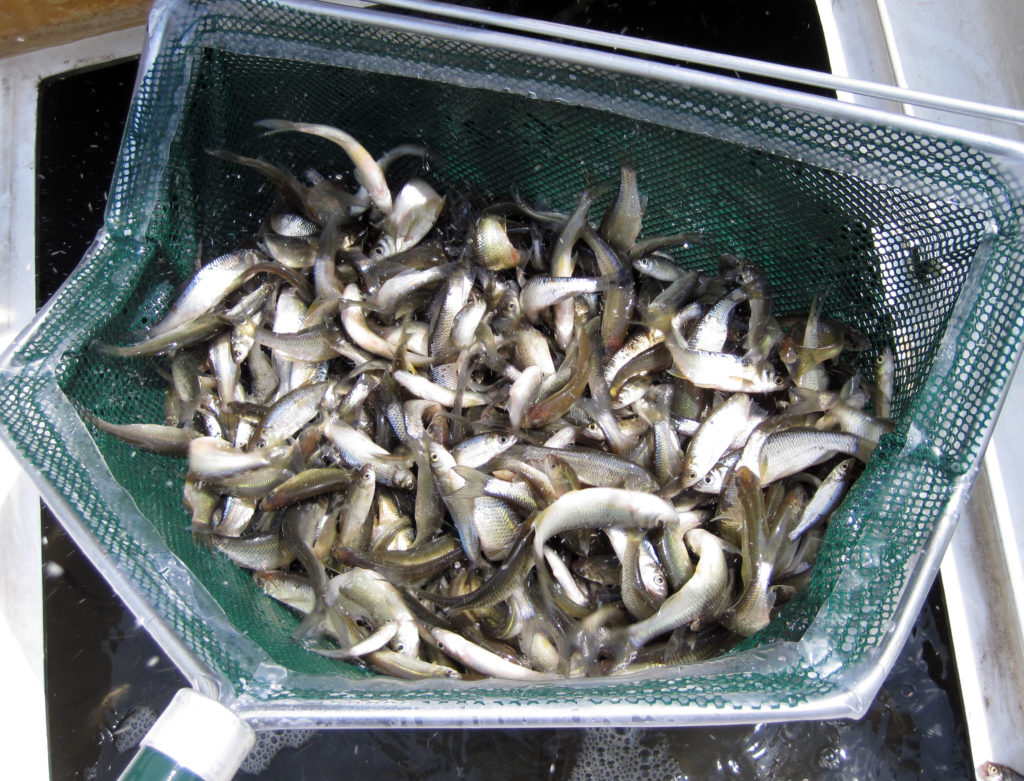
Golden Shiner (Notemigonus crysoleucas)
Habitat and biology: The body of the golden shiner is deeply and laterally compressed, with a lateral line that curves toward the belly. The golden shiner is a slow-water fish that thrives in ponds. Spawning occurs from April to July when water temperatures exceed 68ºF. Females lay adhesive eggs in shallow water over vegetation, including filamentous algae and rooted aquatic plants. The eggs are usually broadcast with no nesting or parental care but some golden shiners have been reported to spawn over the nests of both bluegills and largemouth bass. Growth is typically rapid and maturity is usually reached at age 2 although fast growing fish may spawn during their second summer. Zooplankton forms a large part of their diet. They are also known to feed on algae, insects and eggs of other fish species. They grow 2 to 9 inches in length.
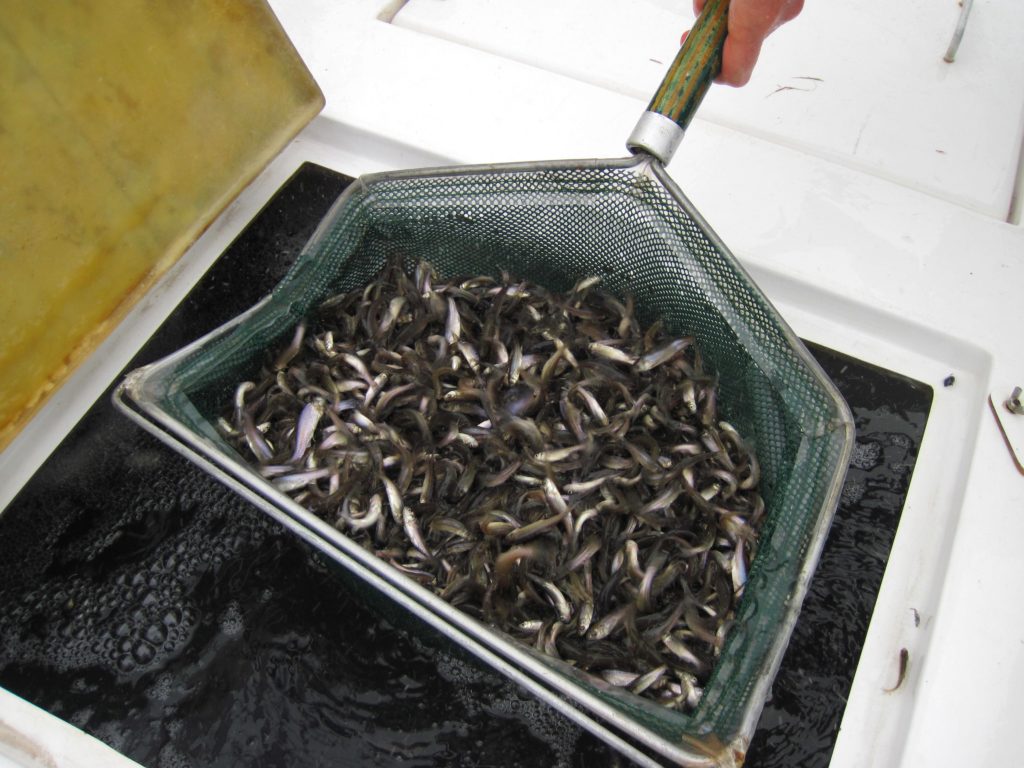
Fathead Minnow (Pimephales promelas)
Characteristics: Their natural geographic range extends throughout much of North America. The fathead minnow is generally dull olive-grey, with a dusky stripe extending along the back and side, and a lighter belly. There is a dark blotch midway on the dorsal fin. Breeding males acquire a large, grey fleshy “fat head” during breeding. They average about 3 inches as adults.
Habitat and biology: The fathead is quite tolerant of turbid, low-oxygentated water, and can be found in muddy ponds and streams that might otherwise be inhospitable to other species of fish. Their diet consist of small invertebrates, detritus, and algae. Spawning occurs in still-water habitats along the shore. Spawning occurs naturally from May through August (15EC to 32EC) in calm shallows of streams and along shorelines in ponds. Males select and prepare the nest site defending it from intruders and only allowing persistent females to enter and spawn. Nests are typically located on the undersurface of submerged stones or branches. Females spawn every 2 to 16 days producing up to 10,000 eggs in a three month breeding season (Gale and Buynak, 1982).
Note: Fathead minnows are a proven method to reduce or eliminate mosquito larvae from small impoundments and drainage ditches. They are less aggressive than mosquito fish and are a great alternative species when necessary.
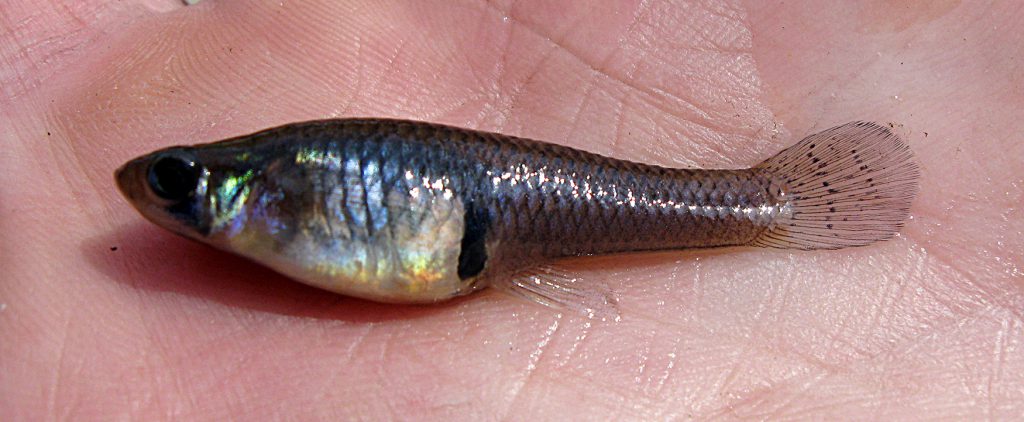
Eastern Mosquitofish (Gambusia holbrooki)
Characteristics: The eastern mosquitofish resembles a freshwater guppy. They are small, only growing up to 2 inches long and are light olive-brown color on top, with silvery sides and a yellowish belly. They have rows of black spots on their dorsal (back) fin and caudal (tail) fin. Its mouth is near the top of its head, and it has a black “tear drop” under its eye.
Habitat and biology: Mosquitofish are quite tolerant of turbid, low-oxygentated water, and can be found in muddy ponds and streams that might otherwise be inhospitable to other species of fish. They like places with muddy bottoms, shallow water, and lots of plants. Mosquitofish breed from April to August. Female mosquitofish are one of our few native livebearing fish. This means baby fish are born alive; mothers do not lay eggs. One female fish can give birth to more than 200 young each year. Fry (baby fish) are born three to four weeks after mating. They will eat just about any living thing that fits in their mouth, including: worms, mites, small crustaceans, insects (aquatic and terrestrial), snails, tadpoles, and algae. With an increase of competition, this species will switch from a diet rich in plankton, algae and detritus to one consisting of zooplankton, other invertebrates, the larvae of many species and plant-associated animals
Note: Mosquitofish are very aggressive. They attack and shred the fins of larger fish. They also eat eggs and young of other fish, including largemouth bass. Though they are a proven method to reduce or eliminate mosquito larvae from small impoundments and drainage ditches fathead minnows are preferred for this, and they should be used only when necessary and under the appropriate conditions.
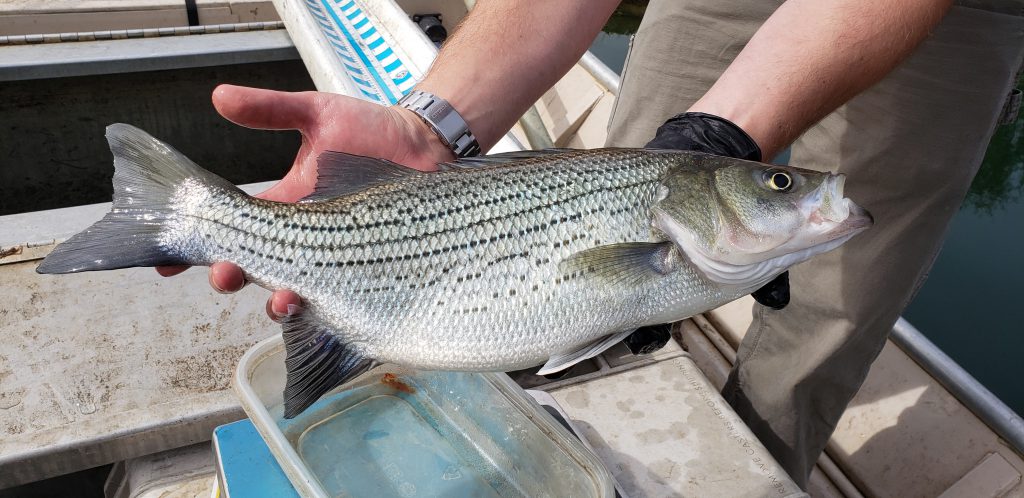
Hybrid Striped Bass (Morone chrysops x saxatilis)
Characteristics: The hybrid stripe bass is often referred to as palmetto, wiper and whiterock, sunshine, and Cherokee bass and is not naturally occurring specie. Individuals are produced by artificially spawning a male white bass with a female striped bass. Offspring usually exhibit a wide variety of color patterns which can be confusing when trying to separate them from the young of either parent specie. As they grow older, hybrid stripe bass become thicker and deeper-bodied, giving them a distinctive short and stocky appearance.
Habitat and biology: Hybrid striped bass are released into rivers, reservoirs, and public lakes. They are considered better suited for culture in ponds than either parent species because they are more resilient to extremes of temperature and to low dissolved oxygen. They feed heavily on shad and grow rapidly, often reaching total lengths of 18 inches or more in two years. Individuals in rivers can migrate great distances in response to changing seasons and flow regimes and they congregate in tailwaters below dams in spring and during high discharge periods. They can provide an excellent winter fishery when many other game specie are inactive. Hybrid stripe bass rarely reproduce in nature, but they are known to occasionally back cross with white bass. They can grow 15 to 20 inches in length.
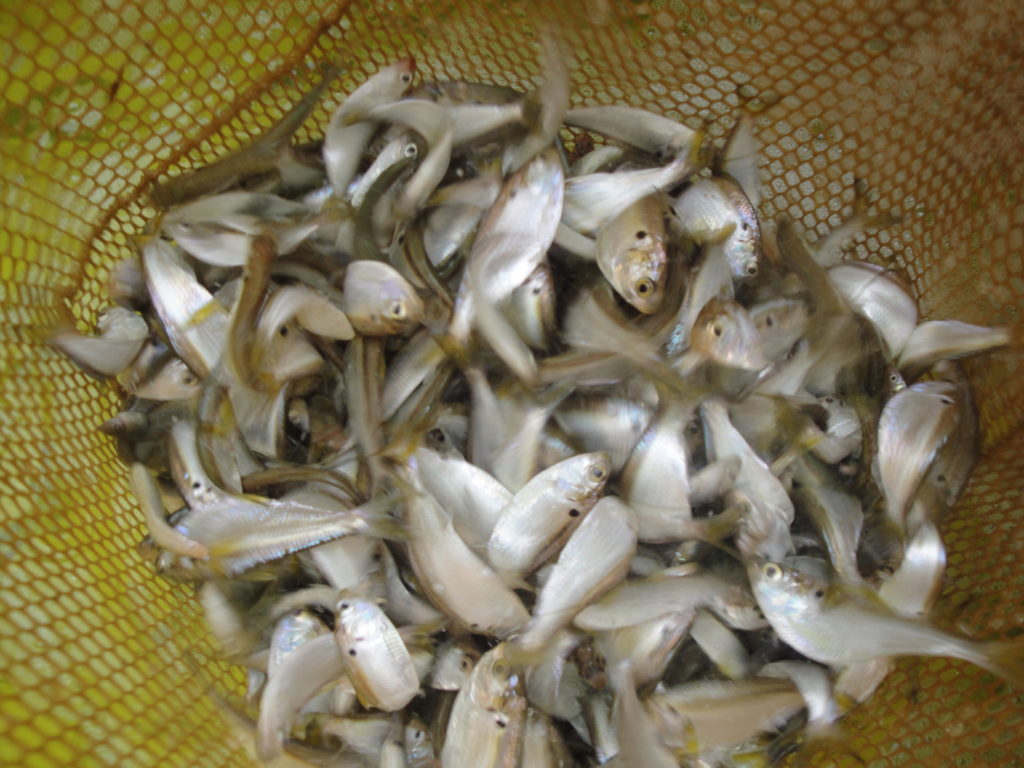
Threadfin Shad (Dorosoma petenense)
Habitat and biology: This pelagic, plankton-feeding species occurs in large, often single-size schools. Spawning typically occurs from dawn to sunrise, when water temperatures reach 70ºF. The eggs adhere to submerged and floating objects. Females lay from 2,000 to 24,000 eggs. The young and adults feed on a variety of planktonic organisms and organic debris. This fish is very sensitive to changes in temperature and dissolved oxygen, and die offs are frequent in fall and late summer especially when water temperature reaches 42 °F. This fish is widely introduced throughout the U.S. as a forage fish for game fish. Life expectancy seldom exceeds 2 to 3 years and they grow 5 to 7 inches in length.
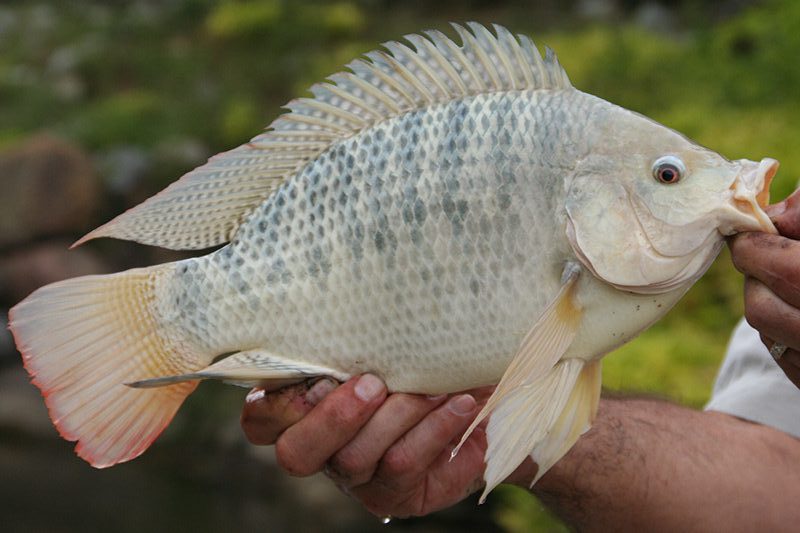
Tilapia (Oreochromis spp. & Tilapia spp.)
Characteristics: There are many different species of tilapia. They can reach up to 20 inches and resemble a two-pound bluegill when fully grown. Their native range includes tropical and subtropical Africa, and the Middle East
Habitat and biology: Tilapia are tropical fish species that resemble our native sunfish and can control certain aquatic vegetation. Blue tilapia feed entirely on algae (both planktonic and filamentous) but do not readily consume submerged vascular plants. Redbelly tilapia feed primarily on submerged vascular plants rather than algae, but most pond managers prefer triploid grass carp for control since grass carp offer multiple-year control and are easier to manage. Because tilapia are tropical fish, they cannot survive normal winter water temperatures in most of the U.S. Annual restocking is generally necessary unless a warm water supply (such as thermal spring or power plant cooling reservoir) is available as a refuge where the fish can overwinter. Tilapia are stocked in the spring and reproduce often, and their offspring also assist in the control of aquatic plants. They have demonstrated control of algae in approximately one month. They are an excellent food fish and can be eaten if caught. The high rate of reproduction, coupled with the high fry survival and fast growth, make tilapia excellent supplemental forage for largemouth bass.
Note: Tilapia are not native to the United States and should never be moved from pond to pond. They out-compete native fish and can harm entire ecosystems. Tilapia should only be stocked by a professional biologist who possesses a permit and are certified by each state.
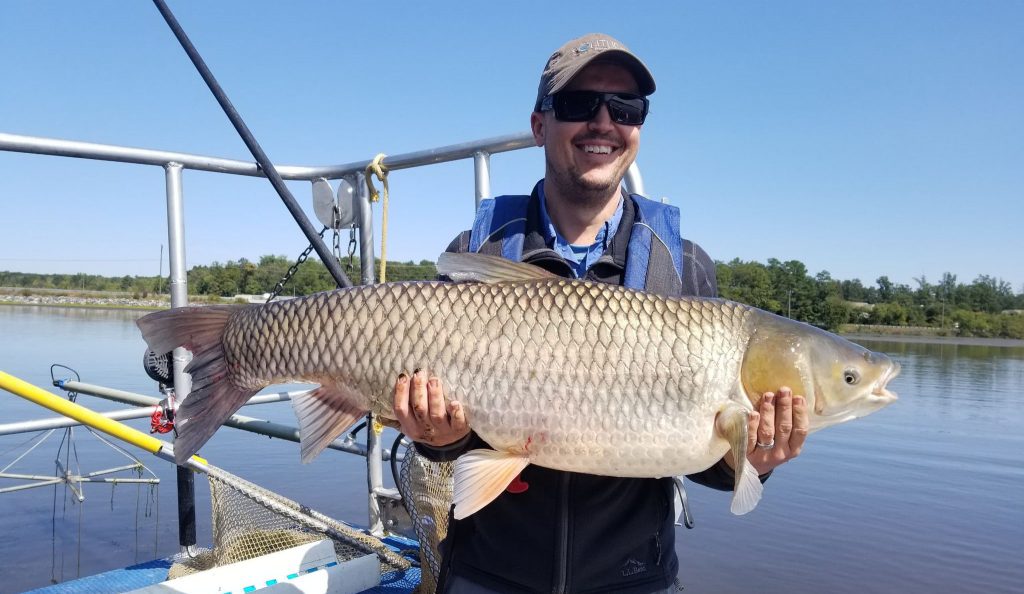
Triploid Grass Carp (Ctenopharyngodon idella)
Habitat and biology: This species is extensively stocked throughout the U.S. to control aquatic vegetation. The process for producing triploid fish involves shocking eggs with a rapid change in temperature or pressure. This process is not usually 100% effective, therefore, in the U.S., the young are tested for triploidy using DNA testing before being sold. It is still not legal to stock triploid grass carp in some states. Adults feed primarily on vegetation, consuming up to 3 times their weight in food each day. Once grass carp are stocked in a water body, it may take several years for them to gain control over the vegetation. Often times in the summer you will find carp near the surface in shallow water, this is because as they prefer warm water. They typically live 5 to 10 years and can grow very large reaching over 50 lbs.
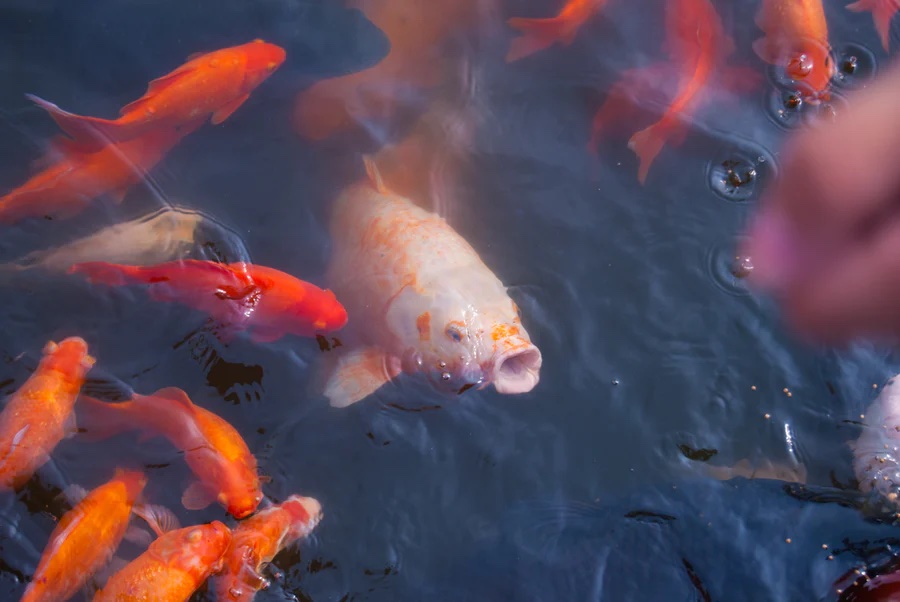
Koi (Cyprinus carpio)
Characteristics: Koi are ornamental varieties of domesticated common carp (Cyprinus carpio) that are bred for decorative purposes in outdoor koi ponds or water gardens. Koi varieties are distinguished by coloration and patterns. Some of the major colors are white, black, red, yellow, and blue. Koi have prominent barbels on the lip that are not visible in goldfish.
Habitat and biology: Similar to common carp, Koi will thrive if stocked in small ponds and large impoundments, especially those made fertile by runoff and discharge of agricultural and domestic wastes. They feed mostly in the mud, consuming worms, insect larvae, and plankton. Koi are cold-water fish, but benefit from being kept in the 59-77°F range, and do not react well to long, cold, winter temperatures; their immune systems “turn off” below 50°F. Koi’s bright colors put them at a severe disadvantage against predators. Herons, kingfishers, otters, raccoons, cats, foxes, badgers and hedgehogs are all capable of emptying a pond of its fish. Koi can live to nearly 50 years old.
Note: Care should be taken that proper oxygenation occurs over the winter months in small water ponds. Though koi are domesticated common carp that are selected or culled for color; they are not a different species, and will revert to the original coloration within a few generations if allowed to breed freely.
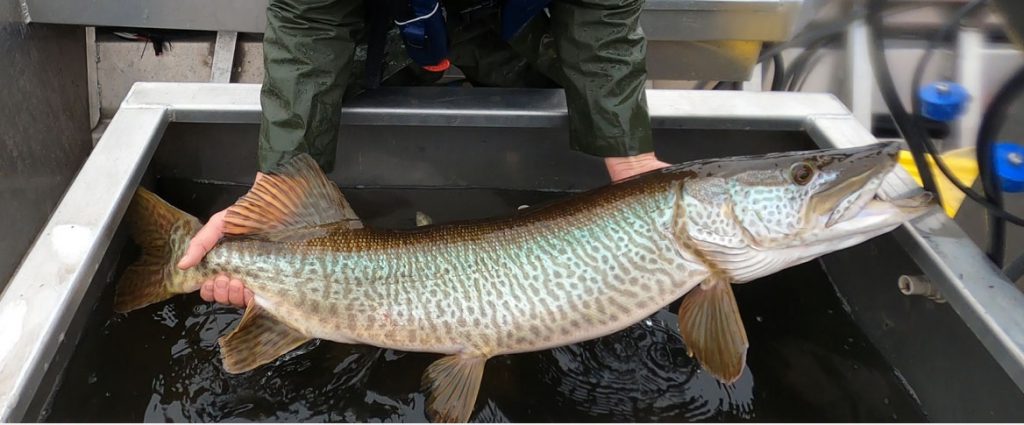
Tiger Muskie (Esox masquinongy x Esox Lucius)
Characteristics: The tiger muskellunge are the sterile hybrid offspring of the true muskellunge (Esox masquinongy) and the northern pike (Esox lucius). Tiger muskie display irregular shaped dark colored vertical markings on a light background. Sides sometimes have alternating patterns of bars and spots on a light background. Its fins and tail lobes are rounded like a northern pike’s but colored like a muskie’s.
Habitat and biology: Tigers, like their parent species, typically inhabit swallow water areas of lakes and rivers. They patrol outside weed edges, inside weed edges and hold under canopies of submerged vegetation. Tigers also hold off points and along weedy bars. In the heat of summer, when water temperatures approach 80°F, large tigers move to cooler, deeper water close to the thermocline, or near underwater springs and offshore humps. Tigers have food preferences similar to those of the true muskie, though it seems to prefer larger fish. They are typical ambush predators and will lie in wait for prey, holding perfectly still for long periods and then exhibit remarkable acceleration as they strike. Its diet is varied and voracious and includes almost all types of fish, small mammals, ducks and amphibians. They can live up to 26 years and can grow quite large with lengths commonly reaching up to 59 inches and weights around 30 lbs.
Note: Tiger muskies are often stocked to add a unique fishing opportunity for a large predator in a fishery. They grow much faster than their pure strain parents and endure high temperatures better than either parent does. Larger size at stocking has been correlated with higher survival rates and the effect is large enough that it is usually cost-effective to stock larger juveniles.
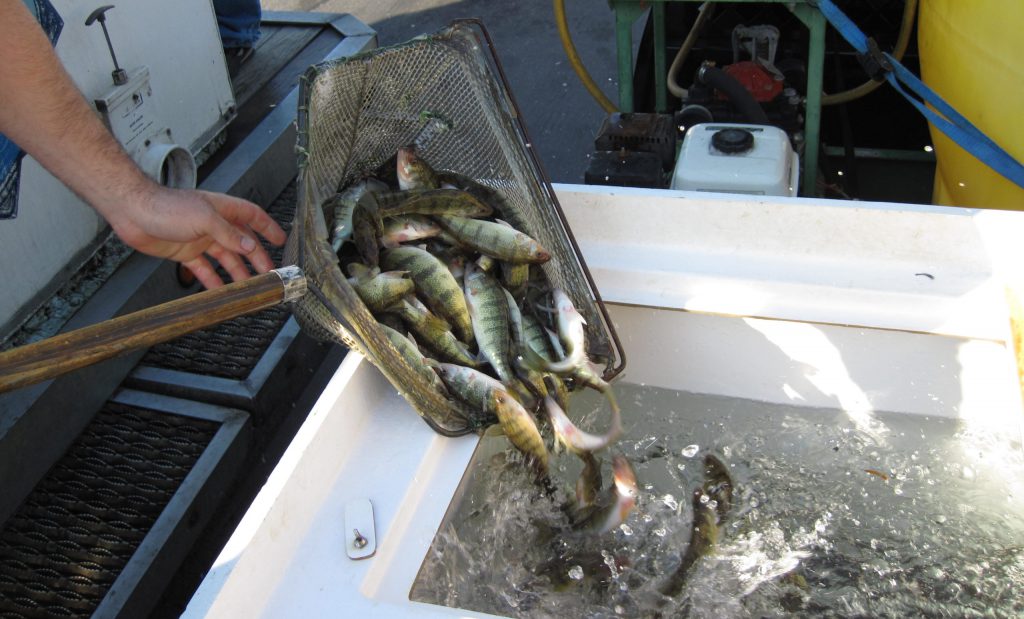
Yellow Perch (Perca flavescens)
Habitat and biology: Yellow Perch are a cool water species and often travel in schools. They feed most actively during the day and often rest motionless at night. Adult perch usually occupy deeper waters than juveniles do. Small yellow perch eat microcrustaceans and insect larvae. Large adults consume small fishes and large crustaceans. Spawning occurs from March to May when water temperatures reach 45⁰ to 52⁰F. Spawning occurs in water 5 to 10 feet deep over sand, gravel, rubble, brush or vegetation. Gelatinous strands of eggs are scatted over sand and gravel substrates or draped over vegetation or submerged snags and can get 2 to 7 feet long. Hatching takes place in about 8 to 10 days. Yellow perch can live as long as 9 years and they grow 3 to 12 inches in length.
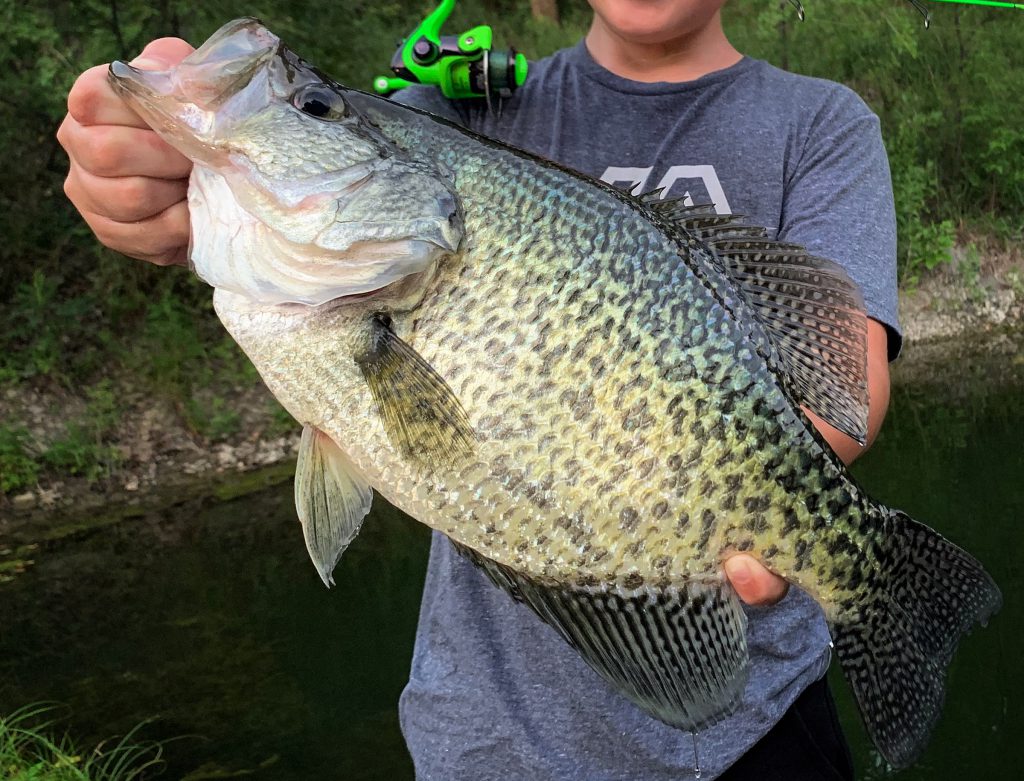
Black Crappie (Pomoxis nigromaculatus)
Habitat and biology: Spawning season is April to May when the water temperatures are higher than 68ºF. Before spawning, black crappie form schools and venture to feed into shallow water where they can be caught in large numbers. Nests are constructed in water 10 inches to 2 feet deep. They are usually built in sandy bottom in weedy areas. Eggs hatch in 3 to 5 days. Young crappies are plankton feeders but older fish feed on insects and fish. Considerable feeding takes place at night. They can live for eight years and grow 12 to 18 inches in length. Crappie are a predator species and tend to become over populated, especially in smaller ponds.
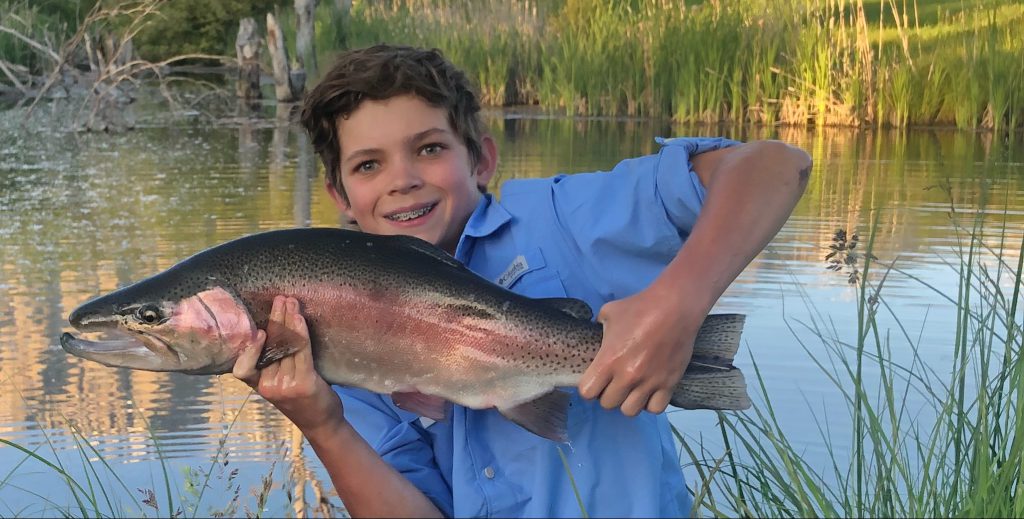
Rainbow Trout (Oncorhynchus mykiss)
Habitat and biology: Rainbow trout can adapt to a variety of habitats, given proper temperature and water quality conditions, and to flow regimes ranging from pools to calm eddies in riffles. A temperature range from 54º to 66ºF is optimal, and reproducing populations require a seasonal drop in temperatures below 55ºF. The spawning season may last from January to May but usually is concentrated in April. Spawning usually takes place in streams over gravel beds. The eggs are rather large and can vary from 650 to more than 12000. Hatching is very dependent on temperature and can take place in 18 days or as long as 101. Growth is extremely variable, depending on temperature, food, and even genetics. Some males will mature in as little as 9 months but usually reach maturity at 2 years. Spawning mortality is high and less than 10% of the females, and even fewer males, live to spawn a second time. Rainbow trout feed on aquatic and terrestrial insects, plankton, larger invertebrates, and even small fishes. They typically live 4 to 8 years and can grow 9 to 29 inches in length.
Note: Rainbow trout are a great seasonal forage fish. When stocked in bass ponds in the fall they provide extra food all winter. In the spring, as water temperatures warm trout begin to slow, making them easy prey for hungry bass that have just completed spawning.
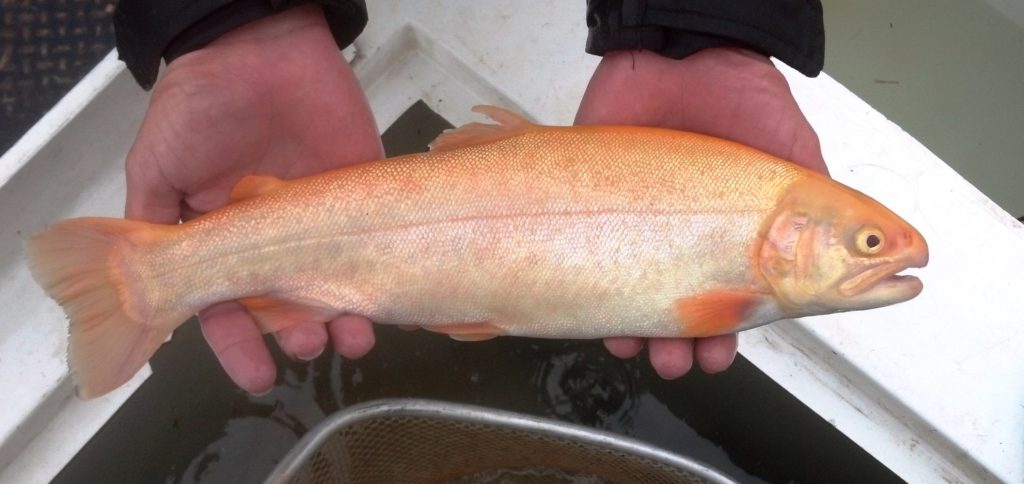
Golden Rainbow Trout (Oncorhynchus mykiss)
Characteristics: The golden rainbow trout is gold to orange on its back and sides fading to a creamy white underside and belly. The wide pink band characteristic of all rainbows is present, but may not be as pronounced as in pure strain fish. Their body form is spindle-shaped, and the mouth is terminal and large and none of the fins have spines. Their eyes can be red or wild type. A fleshy adipose fin is present between the caudal and dorsal fins. Scales are very small and surrounded by a thick mucus coat.
Habitat and biology: Golden rainbows were originally developed from a single fish with a color mutation in a West Virginia hatchery in 1955. Her decedents were selected and spawned for years to create the strain, before being stocked in 1963 as West Virginia’s “Centennial golden trout.” These fish have the same habitat and temperature preferences as their wild counterparts, though they suffer higher mortality due to their bright colors being easily spotted by predators. A temperature range from 54º to 66ºF is optimal. Growth is larger and faster than normal rainbows and depends on temperature, food, and even genetics. Rainbow trout feed on aquatic and terrestrial insects, plankton, and larger invertebrates, and even small fishes. They typically live 4 to 8 years and can grow 9 to 29 inches in length. A cross between the West Virgina golden rainbow and normal rainbows is called a Palomino trout. The golden rainbow trout is a different species than the golden trout (Oncorhynchus aguabonita) of California.
Note: Golden rainbow trout make a great addition to a community’s fishing pond. They can also be stocked at smaller sizes as winter forage to help feed hungry largemouth bass. They can be added each fall alone or with pure strain rainbows, and are fun for kids and parents to catch on power bait and spinners.
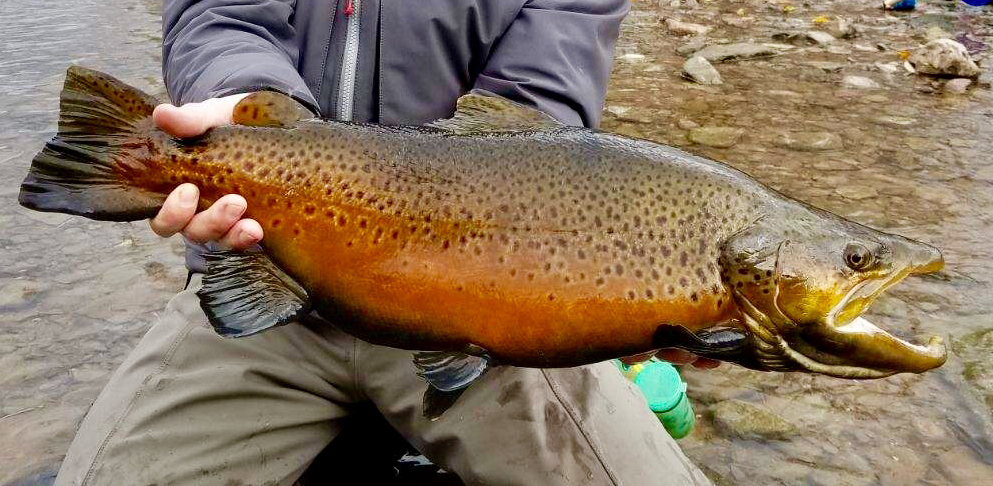
Brown Trout (Salmo trutta)
Characteristics: The brown trout is distinguished by its silver venter and brown or tan back and sides. Large black spots mark the top and sides of the head, back, and dorsal fin, while large red or orange spots with pale haloes appear on the sides. The leading edge of the anal fin is milky white. Large breeding males develop a prominent hook, called a kype, on the lower jaw. The body has small, embedded scales, a fleshy adipose fin and no spines in the fins.
Habitat and biology: Brown trout prefer cool to cold streams, ponds, and lakes, tolerating substrates of hard rock or softer sediments. To survive, they appear to need cover and areas of low velocity for feeding. Brown trout are more tolerant of warmer stream temperatures, preferring a range of 54º to 63ºF, but can survive in temperatures around 75ºF. The brown trout spawns in fall or early winter when water temperatures are 45º to 48ºF. Spawning takes place in shallow gravel areas between pools and riffles, where the eggs are buried and abandoned. Both sexes spawn repeatedly over a period of several days. Hatching takes 148 to 33 days depending on water temperature. Maturity is reached at age 2 to 4 for males and 3 to 5 for females. Juvenile brown trout feed on a variety of prey, favoring aquatic insect immatures. Adults are opportunistic and seek bigger prey, including other fishes, salamanders, frogs, and crayfish. Longevity is eight or more years with some living as long as 18 years. They grow 7 to 31 inches in length.
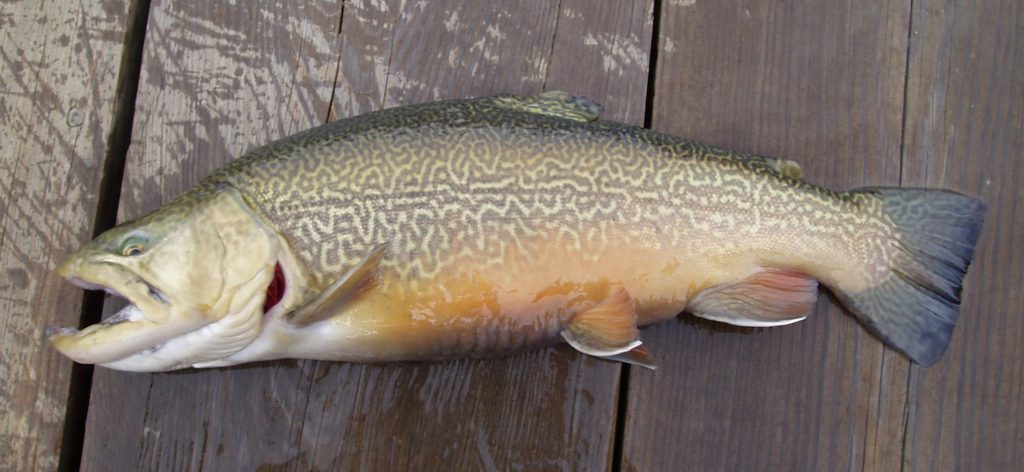
Tiger Trout (Salmo trutta x Salvelinus fontinalis)
Characteristics: The tiger trout is a sterile, intergeneric hybrid of the brown trout and the brook trout. The name derives from the pronounced vermiculations, evoking the stripes of a tiger. It is a rare phenomenon in the wild, with the brook trout having 84 chromosomes and the brown trout 80. Tiger trout can be produced reliably in hatcheries. This is done by fertilizing brown trout eggs with brook trout milt and heat shocking them, which causes creation of an extra set of chromosomes and increases survival from 5% to 85%.
Habitat and biology: Tiger trout have been reported to grow faster than natural species, though this assessment is not universal, and they have been widely stocked for sport fishing. Tiger trout are known to be fish eaters, and are a good control against rough fish populations. This makes tigers popular with many fish stocking programs. Their own population numbers can be tightly controlled as well, since they are sterile.
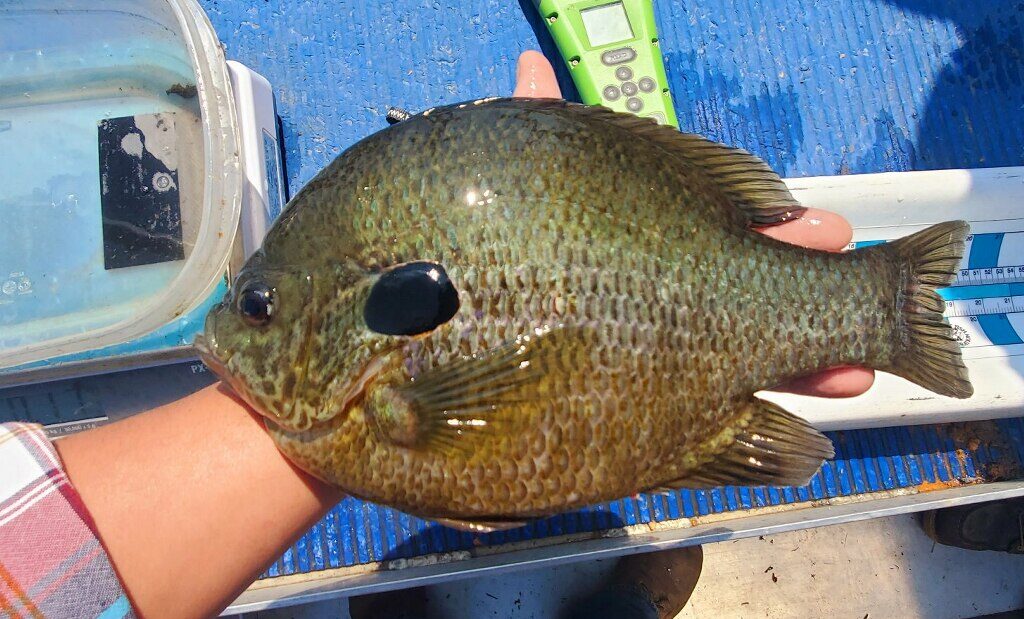
Specklebelly
Characteristics: Specklebelly are ideal for small fishing ponds due to their skewed sex ratio, 95 to 100 percent males. They aggressively eat fish food, grow to large sizes, and are easy to catch. Individuals display some characteristics of both parent species with the added benefit of fast growth, large maximum size, and willingness to take pelleted food.
Habitat and biology: Since this hybrid does not reproduce, the population will need to be maintained through continual stocking. These fish are a safe addition to any new or established waterbody.









